Recent archaeological excavation at a nearly 6,000-year-old site in France has uncovered a grisly find: a pit filled with the amputated arms, hands and fingers. The pit is unlike anything in the surrounding region, or anything known at the time. The archaeologists believe the violent act occurred as a result of war or conflict. [Read the full story on the gruesome pit filled with limbs]
Routine development, ancient finds
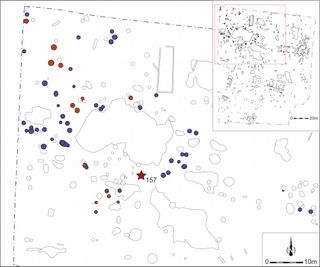
Archaeologists hired to oversee a development project in the village of Bergheim, France uncovered evidence of Neolithic settlement in 2012. They found dozens of ancient pits that were roughly 6,000 years old. Here, a map of the overall site, with spots that contained fossil remains of human smarked in red, and other pits marked in blue. (Photo credit: Chenal et al, Antiquity 2015)
Grisly find
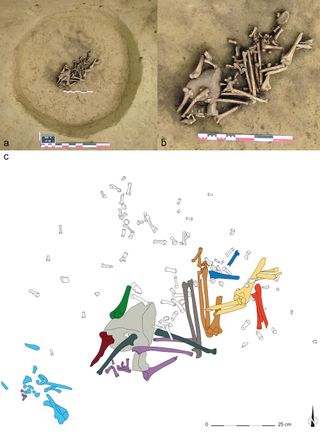
While many of the pits contained human remains, which is not unusual for the time, pit 157 was utterly unique. The bottom of the pit contained fragments of upper limbs from about seven people, including hands that were deliberately cut into pieces. The burial dated to about 5,300 years ago. (Photo credit: Chenal et al, Antiquity 2015)
Bodies above
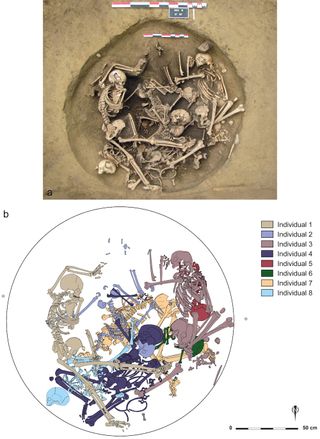
Above the arm bones, the researchers found the bodies of seven other people, each of whom bore marks of violence. Four of the people were children, one of whom was an infant less than 1 year old. Many of them had their arms or limbs severed as well, although the limbs at the bottom of the pit did not seem to come from the people who were buried just above. The bodies were thrown into the pit soon after the upper limbs were. (Photo credit: Chenal et al, Antiquity 2015)
Sign up for the Live Science daily newsletter now
Get the world’s most fascinating discoveries delivered straight to your inbox.
Cut marks
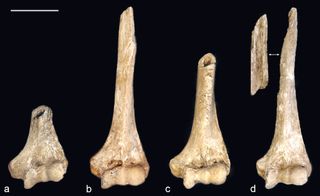
The upper limbs, which included severed fingers, hands and upper arms, showed cut marks consistent with amputation through a violent blow with axe, though some of those cuts may have been finished with a finer tool like a knife. It's likely the body parts were removed after the people had died. (Photo credit: Chenal et al, Antiquity 2015)
Bone fractures
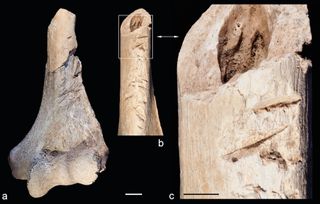
Here, an example of bone fractures found on the forearm bones of some of the ancient victims. (Photo credit: Chenal et al, Antiquity 2015)
Finger bones
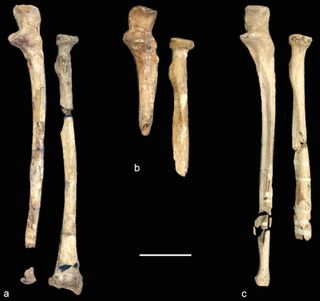
Here, fractured upper arm bones found in the pit. (Photo credit: Chenal et al, Antiquity 2015).
Head wound
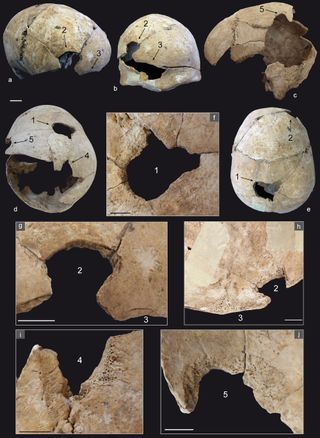
One of the victims of the ancient massacre had evidence of a violent blow to the head. The middle aged man sustained several injuries, including a skull fracture, and also had his upper arm removed. (Photo credit: Chenal et al, Antiquity 2015)
Injuries abound
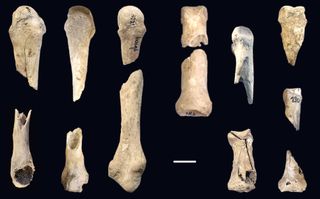
Here, another image of the fractures on portions of the metacarpals and phalanges, which are bones in the hands and fingers. (Photo credit: Chenal et al, Antiquity 2015)
Violent war
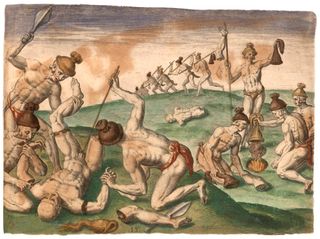
None of the contemporaneous pits found in the world show such signs of extreme violence, so the researchers aren't sure how common this type of event was. However, they think that the likeliest explanation is a violent skirmish or war, rather than a brutal form of justice. Here, a similar depiction of people from the Agua Dulce tribe taking limbs as trophies in the 1500s. (Photo credit: "How Outina’s men treated the slain of the enemy" (engraving 15, published by Theodore de Bry, after an original drawing by Jacques Le Moyne de Morgues, in Brevis narratioeorum quae in Florida Americae provincia Gallis acciderunt, 1591. Public domain, courtesy of Chenal et al)).
Follow Tia Ghose on Twitterand Google+. Follow Live Science @livescience, Facebook & Google+.

Tia is the managing editor and was previously a senior writer for Live Science. Her work has appeared in Scientific American, Wired.com and other outlets. She holds a master's degree in bioengineering from the University of Washington, a graduate certificate in science writing from UC Santa Cruz and a bachelor's degree in mechanical engineering from the University of Texas at Austin. Tia was part of a team at the Milwaukee Journal Sentinel that published the Empty Cradles series on preterm births, which won multiple awards, including the 2012 Casey Medal for Meritorious Journalism.












